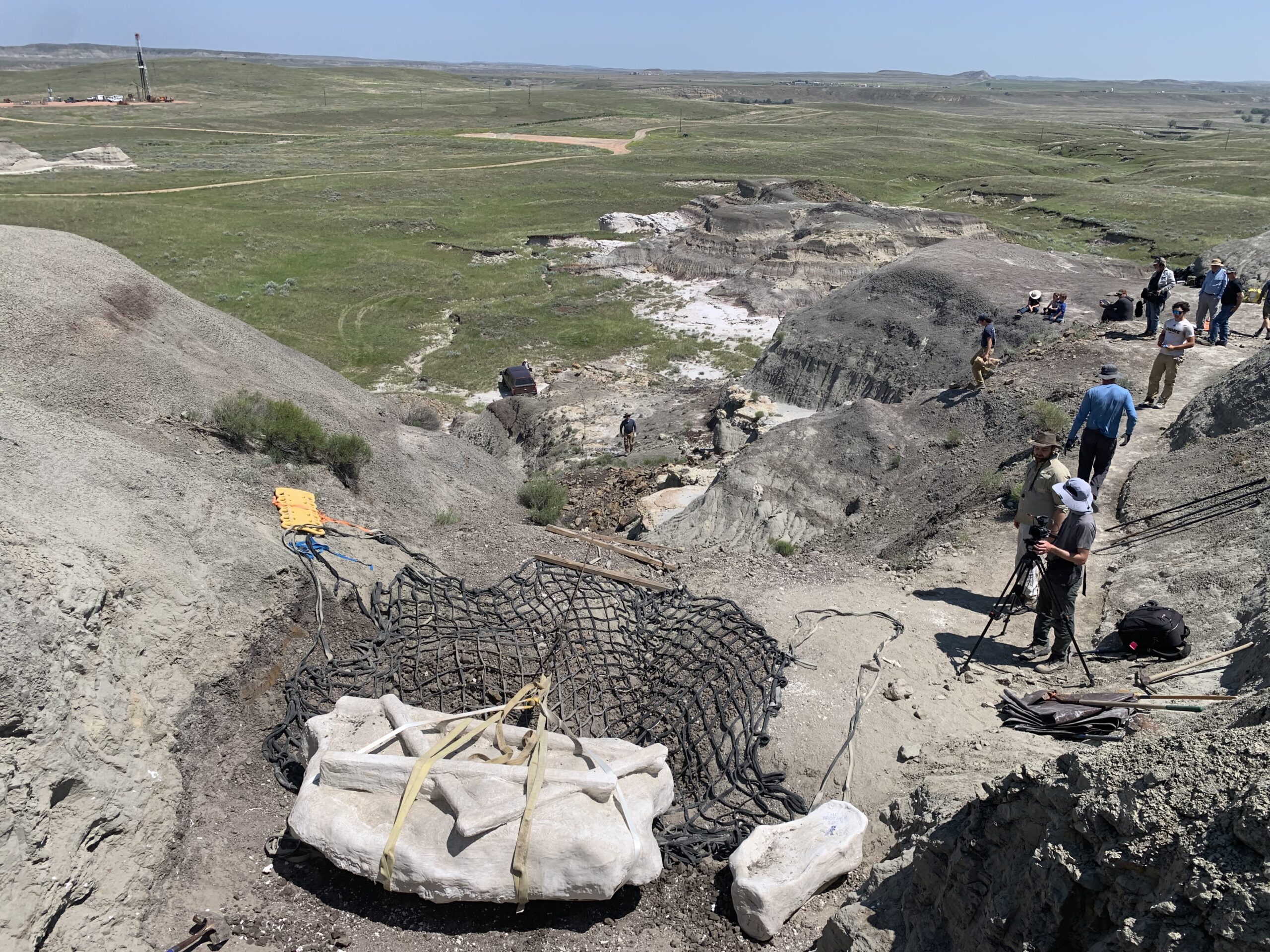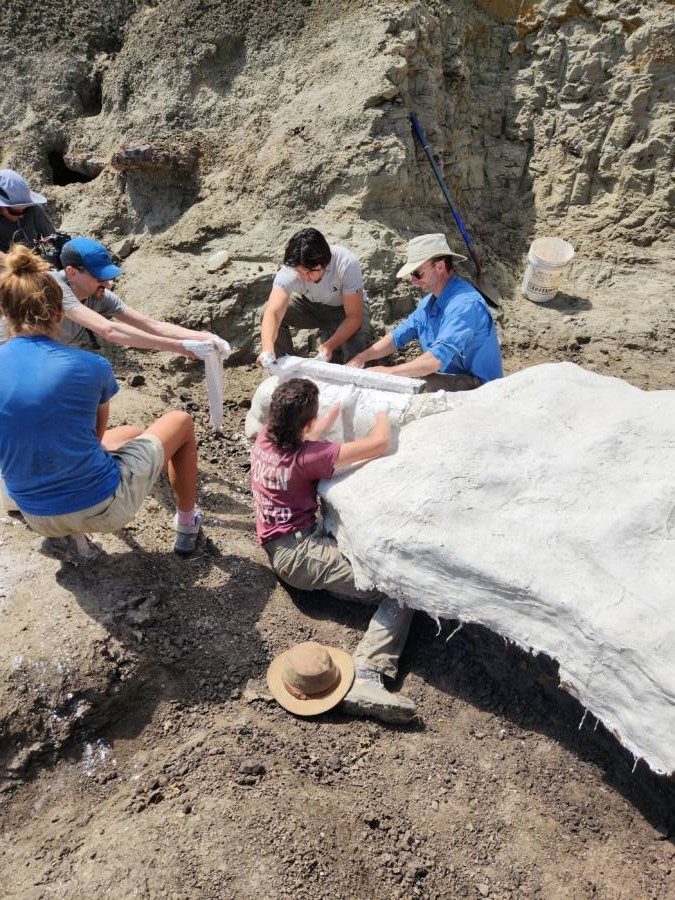A Discovery Hidden in Plain Sight
The North Dakota badlands can look deceptively ordinary to the untrained eye: rolling buttes, scattered rock formations, and a harsh landscape shaped by erosion over millions of years. But in the summer of 2022, three young boys hiking with their father noticed something different, a small fragment of bone peeking out from the earth. That moment, driven by curiosity rather than expertise, would lead to one of the most significant juvenile T. rex discoveries in recent years.
Their find, now known as “Teen Rex,” is not only a scientific breakthrough but a testament to how meaningful discoveries can arise from unexpected places, and unexpected people.
The Discovery: A Family Hike That Changed Everything
The Moment They Spotted Something Strange
Brothers Liam and Jessin Fisher and their cousin Kaiden Madsen were hiking near the Hell Creek Formation, one of the richest fossil-bearing regions in North America. The boys, then ages seven, nine, and ten, were used to the rugged terrain, but this time, something stood out.
They saw what looked like a large, unusual shape embedded in the rock. It wasn’t the typical sediment they were used to seeing.
Their father, Sam Fisher, snapped a photo and decided to send it to an old friend from high school: Tyler Lyson, now the curator of paleontology at the Denver Museum of Nature & Science.
At first glance, Lyson thought it resembled a duckbill dinosaur fossil, one of the more common finds in the area. But as he examined the photo more closely, something didn’t add up.
In a video posted by the museum, Lyson explained:
“It wasn’t until later when I really started to scrutinize the photo that I start to have some suspicions that it might be part of a Tyrannosaurus Rex.”
That suspicion was enough to launch an official excavation.

Launching the Excavation
Lyson and a small team traveled to the site for an 11-day excavation. The boys were invited to help and observe, a rare opportunity to watch a major scientific discovery unfold in real time.
As the team worked, more bone fragments began to appear. But the turning point came when Lyson unearthed something unmistakable:
A T. rex tooth.
Then another.
Then a third.
At that moment, the team knew this was no ordinary find. The fossil belonged to an adolescent Tyrannosaurus rex, one of the rarest age groups to be discovered intact.
“We had just uncovered the lower jaw of this juvenile T-rex,” Lyson said.
Inside the Excavation: Unearthing “Teen Rex”
The Challenges of Excavating a Juvenile T. Rex
Although adult T.rex fossils have been found with relative frequency over the years, juvenile specimens are exceptionally rare. Unlike their massive adult counterparts, young T. rexes had lighter, more fragile bones that were less likely to fossilize completely.
That made the careful excavation even more critical. Paleontologists had to dig with extreme precision, sometimes removing mere centimeters of sediment at a time to avoid damaging the specimen.
The fossil included:
- Portions of the skull
- Teeth
- Vertebrae
- Rib sections
- Parts of the jaw
In total, the skeleton represented one of the most complete juvenile T. rex specimens the museum had ever excavated.
A Dramatic Helicopter Airlift
Once fully excavated, the fossil was wrapped in protective plaster jackets, a standard technique that encases the bones so they can be moved safely.
The site’s remote location meant there was only one way to transport Teen Rex: a helicopter airlift.
Suspended in mid-air and moved across the badlands, the fossil looked as though it were flying, a fitting image for a creature that once dominated the earth below.
It was then transported to Denver, where it now resides at the Denver Museum of Nature & Science, undergoing further study.

Understanding the Hell Creek Formation
Why This Region Is a Paleontology Hotspot
The Hell Creek Formation, stretching across Montana, North Dakota, South Dakota, and Wyoming, is one of the most important fossil regions in the world. It represents the final chapter of the dinosaurs, the last two million years before the catastrophic asteroid impact 66 million years ago.
Famous fossils discovered in the region include:
- “Sue,” the most complete T. rex skeleton ever found
- Hadrosaurs
- Triceratops
- Ancient turtles, crocodiles, and early mammals
The landscape’s combination of fluvial deposits, volcanic ash layers, and erosion creates ideal conditions for fossil exposure, which is precisely how the boys spotted Teen Rex.
How Rare Are Juvenile T. Rex Fossils?
Scientists estimate that only a handful of juvenile T. rex specimens have ever been discovered in reasonably complete condition.
This is partly due to the T. rex life cycle. Adolescents were fast, slender, and built for agility, meaning their skeletons were not as thick or robust as adults’. Their remains were much more likely to be scattered or destroyed before fossilization.
The discovery of Teen Rex therefore provides a rare window into:
- T. rex growth stages
- Changes in bone density
- Shifts in diet and hunting behavior
- Size variability between young and adult individuals
What Scientists Can Learn from “Teen Rex”
Understanding How T. Rexes Grew
Tyrannosaurs were among the fastest-growing dinosaurs ever discovered. A T. rex could go from:
- 1,000 pounds at age 10, to
- 9,000+ pounds fully grown
That means they could gain up to 1,500 pounds per year during peak growth.
“Teen Rex,” estimated at 13–15 years old, represents a critical stage: the transition between a slender, agile juvenile and a massive apex predator.
A Rare Look at Juvenile Bite Mechanics
Adult T. rexes had some of the most powerful bites in history, up to 12,800 pounds of force. Juveniles, however, were built differently.
They had:
- Thinner, sharper teeth
- More flexible skulls
- Likely faster pursuit speeds
This suggests they may have hunted smaller or more agile prey, an insight that only well-preserved juvenile fossils can confirm.
The Boys Behind the Discovery
How a Childhood Adventure Became a Scientific Milestone
For Liam, Jessin, and Kaiden, the discovery was more than a cool moment, it was a legitimate scientific contribution. Few people, even professional paleontologists, get to be part of a major fossil discovery.
Lyson praised their curiosity and persistence, saying:
“By going outside and embracing their passions and the thrill of discovery, these boys have made an incredible dinosaur discovery that advances science and deepens our understanding of the natural world.”
Their find also demonstrates the value of public involvement in paleontology, especially in regions where fossils are naturally exposed.

A Wider Trend: Renewed Discoveries About T. Rex
T. rex research has accelerated over the past decade. Just in recent years, studies have uncovered:
- More accurate size estimates (some adults may have reached 40 feet long)
- Refined bite force calculations
- Clarifications on whether T. rex had feathers
- Insights into social hunting behavior
New fossils like Teen Rex help scientists piece together the gaps in the species’ development, offering clues about how one of Earth’s most iconic predators lived, hunted, and evolved.
Why Discoveries Like This Matter
Advancing Science for the Next Generation
Teen Rex is more than a museum exhibit. It’s a reminder that:
- Science is ongoing
- Major discoveries still happen in the field
- Curiosity fuels knowledge
- Anyone, regardless of age, can make a meaningful contribution
For many visitors, especially kids, Teen Rex will serve as proof that even ordinary people can help uncover extraordinary pieces of Earth’s history.
Final Thoughts
A single moment of curiosity, a glance at an unusual rock, led three young hikers to one of the most important paleontological discoveries in recent memory. Their story is a reminder that the world still holds ancient secrets just waiting to be found, often by those most willing to look closely.
The “Teen Rex” fossil not only advances scientific understanding but also inspires wonder in future generations. And somewhere in the North Dakota badlands, countless other fossils lie waiting, perhaps ready to be discovered by the next group of curious explorers.
Featured image from: Sam Fisher/Denver Museum of Nature & Science

